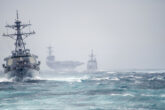September 25, 2024
Integration for Innovation
A Report of the CNAS Defense Technology Task Force
Executive Summary
In August 2023, Deputy Secretary of Defense Kathleen Hicks made a clear case that the Department of Defense (DoD) must do better in “creat[ing] and exploit[ing] change as a military opportunity.”1 To effectively deter conflict, and win should deterrence fail, the broader national security community needs to leverage all elements of U.S. defense ingenuity, from the largest defense contractors to the smallest new entrants. The breadth and depth of today’s challenges demand nothing less.
Leaders in the DoD are seeking to leverage and incorporate private sector advances into military capabilities. Many of these efforts to date have been “bottom-up,” warfighter-driven actions to solve specific tactical needs. There are several cases of “top-down,” leadership-driven projects, but these instances have required leaders at the highest levels of the department to scale and cut through bureaucracy. While significant progress has been made in terms of organization and authorities, barriers and challenges remain to implement new capabilities at scale.
While the DoD is able to deliver relevant, urgent capabilities to U.S. warfighters at speed and scale from traditional and nontraditional sources with existing authorities, policies, and procedures, it fails to do so in a regular, institutionalized fashion because of a risk-averse culture that often does not leverage existing options that are new, agile, and responsive. This report identifies seven integrated factors required to achieve this speed and scale:2
- Senior Leader Support: Leadership within government and industry must create a supportive culture with appropriate resourcing and the necessary talent. Leadership support must be paired with execution mechanisms that can translate inputs into actions.
- Empowered Product Team: This engine drives the entire effort by employing delegated authority to integrate multidisciplinary inputs from government and industry by combining operators, technologists, engineers, acquisition professionals, security experts, and budgeteers with team leadership.
- Defined Problem Statement: A “concise statement of what problem is going to be solved in the context of a larger mission and overarching strategic guidance” requires sufficient specificity to guide the capability development process without being prescriptive.3 Such statement of mission need allows an empowered product team to explore and iterate a range of solutions.
- Iteration with End-User Feedback: Early iteration, experimentation, and testing result in better acquisition outcomes, system performance, and end-user acceptance. Utilizing a DevAcqOps approach focused on modular systems and open architectures results in shortened timelines, creates feedback mechanisms, and improves customer outcomes.
- Acquisition Tradecraft: This is the know-how of contracting vehicles and acquisition tools to repeatably streamline the DoD acquisition system with tailored approaches that result in an effective acquisition outcome.
- Identified Transition Partner: Deploying an innovative capability to warfighters requires movement from development to acquisition and sustainment with a transition partner. As technology enables more hardware-enabled and software-defined systems, challenges can often arise as software becomes the driver of war fighting capability, and traditional paradigms of system ownership erode. Moving to a capability of record approach may permit greater agility to identify transition partners for an increasingly software-defined future.
- Consistent Funding: Good planning and responsible financial execution require stable funding. Consistent funding “represents buy-in both from broader Departmental budget offices and Congress. This is the ultimate form of stakeholder consensus.”4
Flowing from these seven factors are four thematic and deliberately broad recommendations. The goal is to improve the speed and scale of innovation across the breadth of the Department of Defense and national security community:
- Improve Innovation Leadership: Senior leaders across the DoD should hold themselves personally accountable for specific innovation initiatives with clear, public updates and success metrics. This action will provide an example for leaders at lower echelons to adopt similar accountability and success metrics.
- Develop Talent: The military services need to create talent management and career development pathways for innovation leaders that rotate promising individuals through, at a minimum, operational, research and development (R&D), and acquisition assignments. Emphasizing cross-functional experience recognizes the basis of success for many of the best program managers in the DoD today.
- Create Iterative, Flexible Processes: The DoD must embrace an acquisition culture that drives modular, agile, iterative, and responsive approaches across the widest possible array of programs. A DevAcqOps approach that reduces foundational technical risk in a program’s life while embracing iteration and adaptation is vital to maximize both overall system performance and mission fit.
- Increase the Velocity of Innovation: The DoD needs to increase the number of programs that adopt rapid, iterative approaches to fielding capability. This action is only possible if Congress provides flexible and timely funding that allows the DoD to move funds in the year of execution. Allowing program executive offices (PEOs) to address the art of the possible, both in terms of acquisition tradecraft and available technologies, will catalyze innovation velocity across the DoD.
If implemented, these broad recommendations will improve the DoD’s ability to field new capabilities with speed and at scale. In an environment characterized by multiple geopolitical threats to a rules-based world order, it is incumbent upon the DoD to continue evolving its business systems to allow emerging technologies to be applied to war fighting capability in a relevant timeframe.
Introduction
In August 2023, Deputy Secretary of Defense Kathleen Hicks made a clear case that the Department of Defense (DoD) must do better in “creat[ing] and exploit[ing] change as a military opportunity.”5 The emergence of capable and dynamic peer competitors, namely the People’s Republic of China (PRC) and a revanchist Russia, are stressing U.S. global interests. To effectively deter conflict, and win should deterrence fail, the broader national security community needs to leverage all elements of U.S. defense ingenuity, from the largest defense contractors to the smallest new commercial entrants. The breadth and depth of today’s challenges demand nothing less.
At the same time, sources of technological advancement
for military systems increasingly exist outside the
established defense industrial base. The 2023 National
Defense Science & Technology Strategy identifies 14
critical technology
areas: biotechnology,
quantum science,
future generation
wireless technology
(futureG), advanced
materials, integrated
network system-of-systems,
trusted artificial
intelligence (AI) and
autonomy, renewable
energy generation and storage, microelectronics, space
technology, advanced computing and software, human
machine interfaces, directed energy, hypersonics, and
integrated sensing and cyber.6 Of these emerging technologies,
11 (80 percent) are being incubated and developed
by a range of nontraditional suppliers outside the legacy
defense industrial base.7
This reality is neither new nor surprising. During the
Cold War, the U.S. government was the dominant source
of research and development (R&D) funding. However,
by the mid to late 1970s, this trend reversed with business
sector R&D spending overtaking government outlays.8
This accelerated in the late 1980s and continues today. In
2022, business spending on R&D funding hit an all-time
high, accounting for over 71 percent of all U.S. R&D
spending. This pattern is not because of declining government
spending, but rather the massive explosion of
business spending on applied R&D activities.
Observing this trend, DoD leaders are seeking to
leverage and incorporate private sector advances into
military capabilities. Over the past 20 years, the DoD
established new organizations to accelerate technology
adoption and create homes for innovation, including the
Defense Innovation Unit (DIU), the Strategic Capabilities
Office (SCO), the Office of Strategic Capital (OSC), the
Navy’s Disruptive Capabilities Office, and AFWERX.9 The
challenge is to scale these activities across the department
so that commercial sector innovations can be leveraged
for military capability, often with minor modifications
in order to interface with existing fielded capability and
cyber-hardening.
Many of these efforts to date have been “bottom-up” action driven by warfighters to solve specific tactical needs. There are several cases of “top-down” efforts driven by leaders at the highest levels of the DoD, who wield their rank to cut through bureaucracy in order to rapidly scale innovation. To date, the most successful, large-scale disruptors, SpaceX and Palantir, developed outside the legacy DoD acquisition system. Each had to sue the U.S. government to change its contracting process, which demonstrates the institutional resistance to disruptive business models.10 While significant progress has been made to translate multiple years of congressional authorities, provided in National Defense Authorization Acts (NDAAs), into policy and implementation guidance, barriers and challenges remain to implement technological innovation at scale.
Despite this sobering truth, industrial firms are standing at the DoD’s proverbial gates with innovative solutions to pressing operational challenges. In many instances, there are not clear entry points for such firms to engage with the department to secure meaningful contracts. The DoD has recognized these challenges for at least 10 years. The aforementioned DoD organizations are embracing new pathways for engagement and using expanded acquisition authorities to rapidly contract with new organizations. While significant progress has been made in terms of organizations and authorities, barriers and challenges remain.
For this reason, the Center for a New American Security (CNAS) convened the Defense Technology Task Force in 2023 and 2024. This diverse group from government, industry, academia, and the investment community explored three major questions:
- Given existing authorities, how does the current DoD system need to change in order to realize the potential value in the innovation ecosystem?
- What are the specific changes required from the perspective of alignment, speed, and scale to ensure that needed capabilities reach the field on relevant timelines?
- What lessons can be learned from successes across the broader national security enterprise that can be applied to the DoD?
After initial meetings, the group quickly narrowed its
focus.11 Overall, members agreed that the DoD has the
ability to field hardware, software, and services much
faster than it currently is, while using only existing
authorities. Acquisition practices alone will not speed
capability delivery. The DoD would benefit by implementing
the budget flexibility recommended by the
March 2024 Planning, Programming, Budgeting, and
Execution (PPBE) Commission Report (for which one
of the Defense Technology Task Force tri-chairs and report authors served as vice chair).12 Additionally,
while small, high-performing, and leadership-supported
groups have had notable successes, they have yet to be
replicated across the DoD to become common practice.
Over the course of six meetings, the Defense
Technology Task Force heard from current and past
practitioners about their successes and failures with
defense innovation. Leveraging these discussions, the
collective insights of the task force, separate case study
analysis, and additional research, the authors concluded
that while the DoD is able to deliver relevant, urgent
capabilities to U.S. warfighters at speed and scale from
traditional and nontraditional sources with existing
authorities, policies, and procedures, it fails to do so in a
regular, institutionalized fashion because of a risk-averse
culture that often does not leverage existing options that
are new, agile, and responsive.
Today, the DoD is constrained by nonmaterial factors
relating to people and process. These constraints cannot
be solved by direct legislative intervention or intermittent
senior leader focus. Rather, the culture of DoD must
shift toward rewarding the outcomes of speed and scale
in capability development instead of rigid adherence to
process. In the past, the department has demonstrated
a selective ability to go fast and achieve scale, especially
in wartime. However, regularly leveraging these
approaches across the entire DoD enterprise requires
changing incentive structures for personnel to encourage
rather than punish creativity and appropriate risk-taking.
Based upon the discussion of the Defense Technology Task Force, this report outlines the problems facing
innovation adoption within the Department of Defense
and identifies the common factors behind successful
programs. This analysis is paired with near-term
recommendations that could help change and shape
DoD’s overarching culture to achieve greater agility and
alignment with warfighter needs. These recommendations
include policy and process adaptations that do not
require legislative changes.
The DoD has the tools to achieve these objectives. The
uncertain and increasingly dangerous security environment
from Kharkiv to Taipei stresses the innovation
imperative for the DoD across multiple timeframes and
theaters.
About the Defense Program
Over the past 15 years, CNAS has defined the future of U.S. defense strategy. Building on this legacy, the CNAS Defense Program team continues to develop high-level concepts and concrete recommendations to ensure U.S. military preeminence into the future and to reverse the erosion of U.S. military advantages vis-à-vis China and, to a lesser extent, Russia. Specific areas of study include great power competition, developing a force structure and innovative operational concepts adapted for this more challenging era, and making hard choices to effect necessary change.
Acknowledgments
The authors would like to thank several groups and individuals for their support. To the task force members and participants: Your willingness to contribute your time, expertise, and insights made this effort possible and dramatically enriched this report. To the CNAS team: Stacie Pettyjohn for her overall leadership of the Defense Program and getting this report over the finish line; Molly Campbell for her role as task force coordinator, ensuring that meetings ran smoothly from start to finish and her role writing the Task Force 59 case study; Philip Sheers for his role writing the Project Maven case study; the countless other CNAS staff who helped with meeting execution and note taking; Maura McCarthy and Emma Swislow for their excellent editorial help; and Melody Cook for her wonderful design work. This report was made possible with support to the Defense program.
As a research and policy institution committed to the highest standards of organizational, intellectual, and personal integrity, CNAS maintains strict intellectual independence and sole editorial direction and control over its ideas, projects, publications, events, and other research activities. CNAS does not take institutional positions on policy issues, and the content of CNAS publications reflects the views of their authors alone. In keeping with its mission and values, CNAS does not engage in lobbying activity and complies fully with all applicable federal, state, and local laws. CNAS will not engage in any representational activities or advocacy on behalf of any entities or interests and, to the extent that the Center accepts funding from non-U.S. sources, its activities will be limited to bona fide scholastic, academic, and research-related activities, consistent with applicable federal law. The Center publicly acknowledges on its website annually all donors who contribute.
Download the Full Report
- Kathleen Hicks, “Deputy Secretary of Defense Kathleen Hicks Keynote Address: ‘The Urgency to Innovate,’” (public event, National Defense Industrial Association, Washington, DC, August 23, 2023), https://www.defense.gov/News/Speeches/Speech/Article/3507156/deputy-secretary-of-defense-kathleen-hicks-keynote-address-the-urgency-to-innov. ↩
- Six of these factors were identified in Robert Work, Michael Brown, and Ellen Lord, “Innovation Adoption for All: Scaling Across the Department of Defense,” War on the Rocks, April 3, 2024, https://warontherocks.com/2024/04/innovation-adoption-for-all-scaling-across-department-of-defense. ↩
- 2022 National Defense Strategy (U.S. Department of Defense, October 27, 2022), https://media.defense.gov/2022/Oct/27/2003103845/-1/-1/1/2022-NATIONAL-DEFENSE-STRATEGY-NPR-MDR.PDF; Work, Brown, and Lord, “Innovation Adoption for All: Scaling Across the Department of Defense.” ↩
- Work, Brown, and Lord, “Innovation Adoption for All: Scaling Across the Department of Defense.” ↩
- Hicks, “Deputy Secretary of Defense Kathleen Hicks Keynote Address: ‘The Urgency to Innovate.’” ↩
- 2023 National Defense Science and Technology Strategy (U.S. Department of Defense, May 9, 2023), https://media.defense.gov/2023/May/09/2003218877/-1/-1/0/NDSTS-FINAL-WEB-VERSION.PDF. ↩
- Only 3 of the 14 critical technology areas are “defense specific”; the others are dual-use and the greatest innovation is happening in the private sector. The Office of the Secretary of Defense for Research and Engineering, “Critical Technology Areas,” accessed September 10, 2024,
https://www.cto.mil/usdre-strat-vision-critical-tech-areas. ↩ - Laurie Harris, U.S. Research and Development Funding and Performance: Fact Sheet (Washington, DC: Congressional Research Service, September 13, 2022), https://crsreports.congress.gov/product/details?prodcode=R44307. ↩
- This list is by no means exhaustive, and it is meant for illustrative purposes only. A full accounting of the range of innovation organizations within the DoD would take several pages and is beyond the scope of this report. ↩
- Rolfe Winkler, “Palantir Prevails in Lawsuit Over U.S. Army Contracting Practices,” The Wall Street Journal, October 31, 2016, https://www.wsj.com/articles/palantir-prevails-in-lawsuit-over-u-s-army-contracting-practices-1477940218; Joey Roulette, “Musk’s SpaceX Sues U.S. Air Force over Rocket-Building Contracts: Filings,” Reuters, May 22, 2019, https://www.reuters.com/article/ technology/musks-spacex-sues-us-air-force-over-rocketbuilding- contracts-filings-idUSKCN1SS2SI. ↩
- For more on the Defense Technology Task Force, see Appendix 2. ↩
- Senate Commission on Planning, Programming, Budgeting, and Execution Reform, Defense Resourcing for the Future, March 6, 2024, https://ppbereform.senate.gov/wp-content/uploads/2024/03/Commission-on-PPBE-Reform_Full-Report_6-March-2024_FINAL.pdf. ↩
More from CNAS
-
Stuck in the Cul-de-Sac
For more than a decade, the United States has sought to modernize its military to deter China, but it has become stuck in a developmental cul-de-sac that has allowed China to ...
By Carlton Haelig & Philip Sheers
-
Build a High-Low Mix to Enhance America’s Warfighting Edge and Deter China
The Trump administration can take immediate actions to improve U.S. military capability, capacity, and warfighting to deter China and reverse negative trends in military power...
By Stacie Pettyjohn, Carlton Haelig, Becca Wasser & Josh Wallin
-
To Focus on China, U.S. Needs to Wean off Europe and Middle East Missions
If the United States cannot rebalance its military focus toward the Indo-Pacific it risks expediting Chinese aggression in the region and furthering the decline of the US-led ...
By Carlton Haelig
-
How the Space Force Can Better Tell Its Story
Space Force guardians should use the spotlight from real world events — like this story — to educate the public and advocate for resources....
By Hannah Dennis








